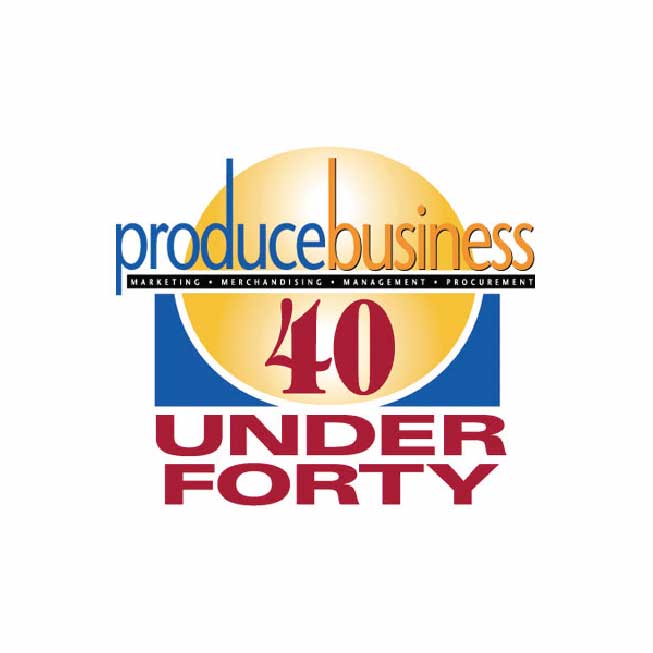As the 2024 Retail Sustainability Award winner, Hannaford’s eco-friendly operations define the store.
Originally printed in the May 2024 issue of Produce Business.
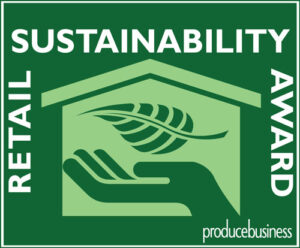

Hannaford Bros. Co.’s Cony Street store in Augusta, ME, epitomizes why Produce Business selected the 189-store retailer as Sustainability Retailer of the Year. The company, the store, and the operations, including produce, go above and beyond.
Hannaford recently remodeled that location with a purpose. In celebration of its 15th year, the Hannaford Cony Street store is pursuing a Living Building Challenge Core green building certification.
The 50,000-square-foot Cony Street store opened in 2009, as the first supermarket in North America to achieve Platinum LEED for Retail certification. Platinum is the highest standard maintained by the U.S. Green Building Council, which means the Cony Street Hannaford store was one of the most eco-friendly stores operating in the United States.
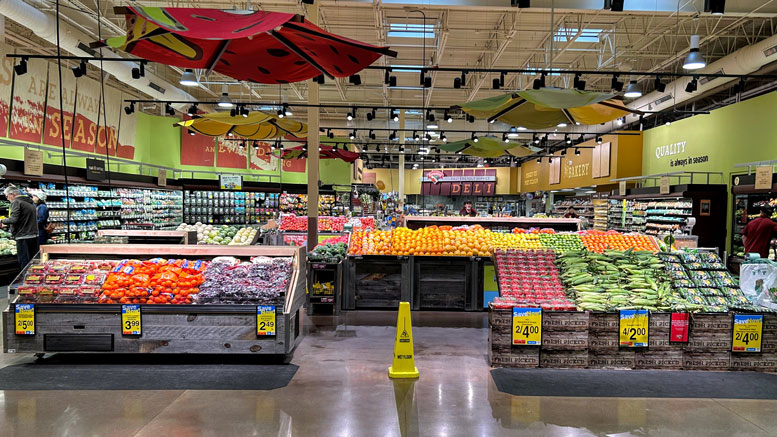

Now, if it succeeds in a year-long evaluation period, the Cony Street store will emerge as the first supermarket in the U.S. to achieve the Living Building Challenge Core for Interiors Certification.
The certification represents an advanced performance-based sustainability standard developed by the International Living Future Institute. The standard covers how a building and its operations support ecology, community, and energy efficiency to advance a sustainable future.
It even has a decor requirement, so the store lobby has two carvings of local fauna, with each of the wood sculptures carved from a single log.
The decor requirement falls into a larger standard that includes 10 imperatives representing best practices for sustainable buildings, such as installation of low-flow fixtures, iceless seafood displays and native, low-water plantings in the landscaping and on the store’s green roof. With those elements in place, the Cony store uses 70% less energy than a baseline building, making it the most energy-efficient store per square foot that Hannaford operates.
ECO-FRIENDLY REMODEL
The remodel had to make locally acquired, sustainable materials a priority, with 20% of it sourced within a 311-mile radius, and 50% of wood incorporated into the design salvaged or certified by the Forest Stewardship Council. Salvaged materials from the existing building, including refurbished refrigerators and concrete floors, were used when possible. At the same time, 80% of renovation waste was diverted from landfills and recycled.
In addition, the store also incorporates features that encourage community members to undertake eco-friendly activities. The Cony store’s layout supports a pedestrian orientation with bike storage, e-bike chargers and access to public transportation.
Even before shoppers get into the store, there is a heated element in the parking lot that cuts down on salt use during snowy days, and wood pillars repurposed from a World War II-era aircraft hangar.
The parking lot also uses lights designed to direct illumination downward and diminish light pollution. The parking lot includes a subterranean reservoir to capture rainwater runoff and keep it out of the nearby Kennebunk River.
Eco-friendly operations define the store, from its rooftop garden to its geothermal heating. Still, the Living Buildings certification requires meeting daily operational standards, hence the one-year evaluation period. The evaluation period continues from the period of the renovation through to the fall of this year, when the final word on the certification will come through.
George Parmenter, sustainability lead for Hannaford, says the genesis of the Hannaford sustainability and the Cony Street store’s development arise from the same concerns.
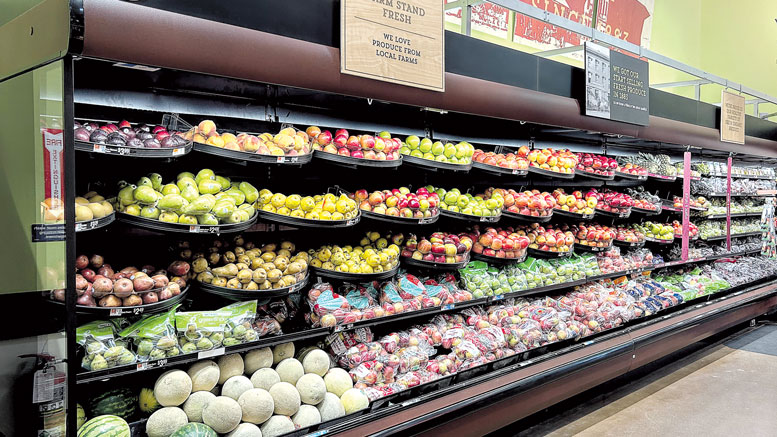

PRODUCE BUSINESS/MIKE DUFF PHOTO
“This building was designed to be a kind of learning laboratory. Everything we could possibly do, we did here,” says Parmenter. “This building has geothermal, it has solar. We built a lot of windows into the building as well as inside the center store, where you’ll see what we call a pop-up pavilion, which allows natural light into the area.”
Natural light filtering through the roof doesn’t necessarily seem like a big deal today, but Parmenter notes having windows in stores was a bit controversial at the time, given the prerogative of keeping consumer minds fixed on what’s in the store.
Similarly, worries arose about doors on cold cases, as they might discourage consumers from shopping them, although they are commonplace today. The Cony Street store has installed doors on cold cases even beyond service counters.
Beyond that, the refrigerator systems incorporate a heat exchange that warms water for use in the store. The store build also included LED lighting, as well as unique materials, such as local stonework, neither of which was mainstream in 2009.
“Everything you can imagine, we tried in this building to see what was commercially viable to go forward,” says Parmenter. “We started adding more natural light to our buildings, using alternative materials, no VOC paints. We built our recycling practices in the store, and those have been set everywhere now, and have evolved over time.”
“We knew this was going to be an investment, and it cost more to build this store than it did the typical supermarket in 2009, but the investment was to figure out what worked and what didn’t work.”
The produce section at the Cony Street store features multiple elements that promote sustainability. For example, cold cases in the produce section have shades that employees can pull down at night or during a power outage. Not only do they save energy, says Parmenter, but the shades keep products from heating up, drying out, or enduring conditions that might lead to deterioration. So, the shades not only cut down on energy use, but also help with the mission to cut down on food waste.
GETTING THE WASTE OUT
Food waste is a priority in Hannaford’s perishables sustainability initiatives. The company has made extensive efforts to minimize the amount of food that ended up in landfills — not only in the produce department, but across the store as well.
Hannaford recognizes the growing, transporting and disposing food cycle generates significant and wasteful carbon emissions, while at the same time disposing of the means to help communities address hunger issues. Three years ago, Hannaford reached a threshold, and is now an industry leader in managing food waste and in working to address climate change, says Mike Emery, director of produce category, pricing and merchandising for Hannaford.
“A large portion of this work occurs in produce, as well as our other fresh departments. Since 2021, Hannaford stores have diverted or donated all food at risk of going to waste, sending no food to landfills,” Emery says, adding Hannaford was the first large-scale supermarket retailer in New England and New York to mark this achievement at every store.
“Hannaford’s multi-pronged approach focuses on first preventing food waste through strategic product ordering and management at the store level.”
As its sustainability initiatives evolved, so did Hannaford’s thinking about other social issues, which plays out in produce department efforts. So, hunger relief plays into how Hannaford addresses sustainability and reducing food waste, as it offers perishable food to organizations fighting hunger, rather than seeing fruits and vegetables trucked to landfills. What might be left over goes to local farmers for livestock feed or a biodigester.
Hannaford also trains associates on how to responsibly handle food to prevent physical damage and exposure to harmful temperature variation.
“Each Hannaford store also strictly follows the U.S. Environmental Protection Agency (EPA) Food Recovery Hierarchy, which prioritizes the rescue of surplus product for donation to food insecure individuals, generating millions of meals donated annually,” says Emery.
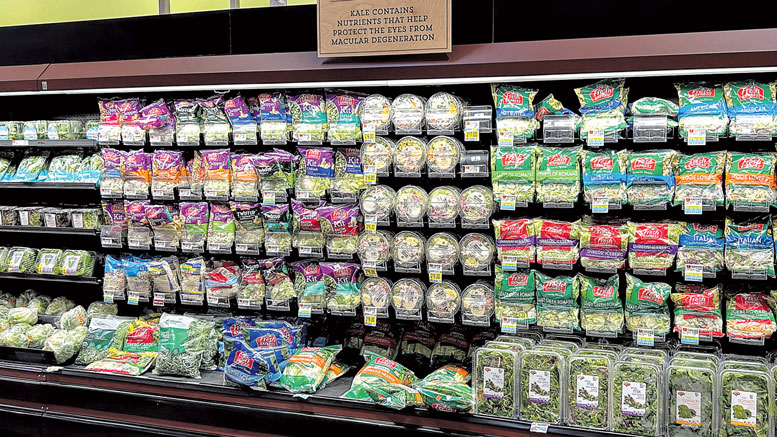

Hannaford’s efforts haven’t been lost on customers, says Emery. “Customer response has been incredibly encouraging and positive,” he points out. “We’re hearing more and more from customers that their environmental impact is driving their purchasing decisions, and they want to shop at a grocery store that aligns with their sustainability goals.
“There’s always more work to do in regard to our sustainability efforts, and we’re committed to being an industry leader in this arena.”
PRODUCE FOCUS
Emery says Hannaford is proud of the products it carries and the company’s support of sustainable practices.
“We are a leader in offering products from controlled agriculture environments, which reduce water consumption and food miles, and many are grown without pesticides or herbicides,” says Emery. “Many of our suppliers are practicing regenerative agriculture, and we continue to learn from, and partner with, other industry leaders on how we can best support our soil health.”
An important link in the Hannaford sustainability effort is its vendors, and Emery says Hannaford carries more than 8,000 items from over 1,000 local vendors across the five states in which it operates, including more than 125 local farmers.
“Hannaford is deeply committed to supporting local farmers and producers,” says Emery. “This provides our customers with the freshest products available while also reducing food miles. We shine a spotlight on our local farmers, including year-round, in-store signage, making it easy for shoppers to identify locally grown items.”
FOCUS ON PACKAGING
Packaging is another produce element that Hannaford has scrutinized, actively looking for ways to reduce packaging and single-use plastics in the department, says Emery.
“We have reduced the number of single-use plastic bags available to customers in our produce department and have developed customer-facing signage reminding customers that not every item needs a bag,” he explains. “We also offer reusable produce bags for customers to purchase and use on their next shopping trip. These efforts have resulted in a 6% year-over-year decline in the number of single-use produce bags used by our customers.”
Hannaford is partnering with many suppliers to test new packaging that uses less, in terms of materials while maintaining produce quality and freshness.
“We expect suppliers to continue pursuing innovative alternatives to make packaging more sustainable,” says Emery. “Retailers will be a part of those conversations as we introduce new packaging to customers while continuing to deliver the value, quality and exceptional experience they’re accustomed to when shopping for produce from Hannaford.”
At the same time, Hannaford has taken steps to make its sustainability program interactive, providing customers with the opportunity to learn and do more.
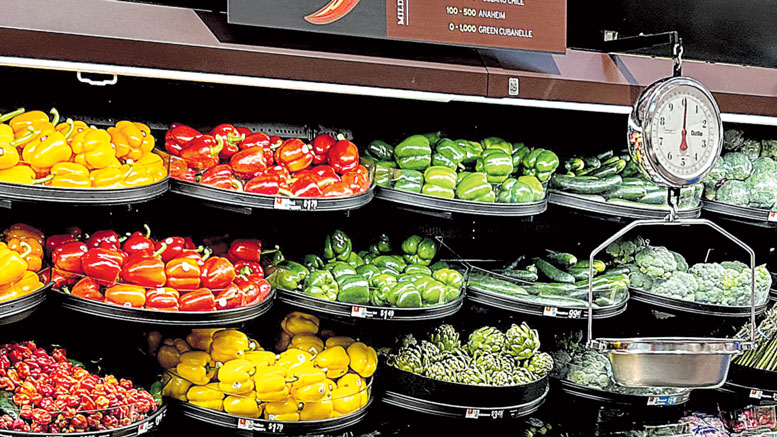

PRODUCE BUSINESS/MIKE DUFF PHOTO
“We regularly work to educate and empower our customers to make eco-friendly choices,” says Emery.
In 2023, Hannaford launched its Planet Hannaford banner, which inspires shoppers to make a big impact on a small level by reinforcing the message that what people do as part of a community adds up.
“Planet Hannaford comes to life for customers in a variety of ways, including in-store collateral, ads in our weekly flyer, online at Hannaford.com, and on our social media channels,” says Emery. “Planet Hannaford invites shoppers to take part in everyday decisions that are better for themselves and the planet, such as using reusable bags, shopping local and in-season, buying only what they need and following the ‘reduce, reuse and compost’ model for waste reduction.”
COMPANYWIDE EMPHASIS
Hannaford’s approach to sustainability on the corporate and store level is comprehensive.
Ongoing efforts include, besides those already highlighted, rating stores on important sustainability-related functions, and the company conversion to all-electric operations.
The produce operation is thoroughly integrated into the sustainability program and is a linchpin, given its role in the complex relationship between highly perishable food, consumers and the environment, both natural and social. Given the consistency of its commitment to environmental well-being, Hannaford is an obvious leader in sustainability as exemplified by Augusta’s Cony Street store.

